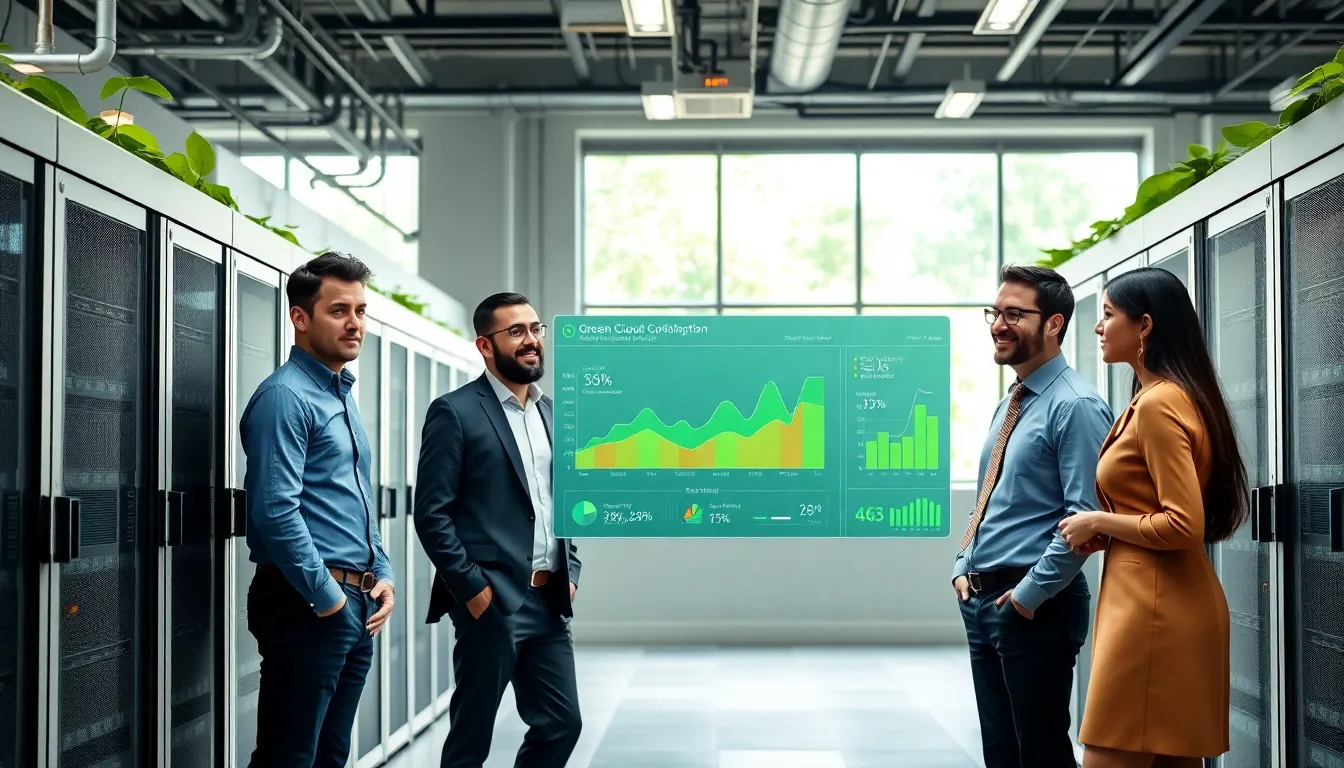In today’s digital world, where data flows as freely as coffee at a Monday morning meeting, green cloud computing is quickly becoming the superhero in the tech universe. Why? Because while your online binge-watching might be burning through energy, green cloud solutions are working hard to lighten the environmental load. Curious about how the cloud can be both fluffy and eco-friendly? Let’s jump into the realm where sustainability meets technology and explore how businesses can save the planet… and their budget.
Table of Contents
ToggleWhat Is Green Cloud Computing?

Green cloud computing refers to the practice of using sustainable and energy-efficient cloud technologies to reduce the overall carbon footprint of computing. At its core, it involves leveraging renewable energy sources, optimizing resource use, and minimizing waste in the data center environment. Instead of just migrating to the cloud for convenience, green cloud computing takes a step further by ensuring that this migration is not at the cost of the environment. It emphasizes practices aimed at reducing greenhouse gas emissions while maintaining efficiency and performance.
While traditional cloud services might prioritize speed and storage, green cloud solutions focus on sustainability, often utilizing technologies like advanced cooling systems, efficient data storage methods, and virtualization to optimize resources. By integrating these practices, companies are beginning to realize that being eco-friendly can also be a smart business move.
In essence, green cloud computing is a way to elevate technological innovation while keeping our planet intact, and who wouldn’t want that?
Benefits of Green Cloud Computing
The perks of green cloud computing are quite compelling, making it an attractive option for forward-thinking organizations. Here are some notable benefits:
1. Cost Efficiency
By utilizing energy-efficient technologies, companies often see reduced energy bills. Also, many green cloud providers offer competitive pricing, especially as renewable energy becomes more mainstream.
2. Reduced Carbon Footprint
Adopting green cloud solutions helps organizations contribute to a healthier environment. This reduction in greenhouse gas emissions translates to a lower carbon footprint, helping deliver on corporate responsibility promises.
3. Brand Reputation
Consumers and other businesses alike are increasingly favoring brands that prioritize sustainability. By showcasing a commitment to the environment, companies can boost their public image and attract new clients.
4. Enhanced Performance
Green technologies are often synonymous with advanced efficiencies. Companies adopting these systems may find their cloud services operate faster and with greater reliability, thanks to optimized resource usage.
5. Regulatory Compliance
As governments worldwide carry out stricter regulations about emissions and waste management, moving to a green cloud may help businesses comply more easily, avoiding potential fines and penalties.
6. Innovation and Collaboration
Embracing green technology can drive innovation within companies. Collaborative efforts among tech providers often lead to new, exciting solutions that benefit both the environment and the bottom line.
Key Technologies and Practices in Green Cloud Computing
To achieve sustainable results, green cloud computing employs various technologies and practices. Here are some key components:
Energy-efficient Data Centers
These facilities use advanced cooling techniques, such as free cooling and liquid cooling, to reduce energy spending. Innovative designs rely on natural resources, significantly decreasing the amount of energy needed to operate.
Virtualization
By virtualizing servers, organizations can maximize hardware usage. This practice allows multiple virtual machines to run on a single physical server, reducing the need for more hardware and, so, cutting energy consumption.
Renewable Energy Sources
Many companies now operate data centers powered by renewable energy, such as solar or wind power. This transition actively reduces reliance on fossil fuels while promoting sustainability.
Resource Management Tools
Effective monitoring tools for managing resources allow companies to analyze usage, pinpoint inefficiencies, and optimize power consumption. This proactive approach also improves overall service quality.
Green Certifications
Adopting standards such as ISO 14001 or LEED can give businesses a framework for operating sustainably. Certification not only shows commitment but also provides guidelines for environmental management.
Challenges in Implementing Green Cloud Solutions
Even though the numerous benefits, transitioning to green cloud computing doesn’t come without its challenges. Here are some hurdles companies may face:
Initial Costs
While potential savings exist long-term, the upfront investment required for new green technologies and practices can be significant. Many businesses are hesitant to allocate budgets to what may appear as riskier ventures.
Compatibility Issues
Integrating new green technologies with existing systems can often lead to compatibility challenges. Companies must ensure that new solutions work seamlessly with their current infrastructure, requiring careful planning and execution.
Changing Organizational Mindset
A shift towards sustainability requires a cultural change within organizations. Employees and leadership alike must embrace environmental considerations in every decision, which can sometimes lead to friction among traditionalists.
Knowledge Gaps
Many businesses lack expertise in implementing sustainable practices. Ensuring that employees are trained and well-informed about green technologies requires dedicated time and resources, two things often in short supply.
Future Trends in Green Cloud Computing
The landscape of green cloud computing is continually evolving, and several trends are emerging:
Increasing Use of AI
Artificial intelligence is being leveraged for optimizing energy usage in data centers. By analyzing data patterns, AI can make real-time adjustments to power settings, significantly improving efficiency.
Growth of Hybrid Cloud Solutions
A hybrid cloud model allows organizations to balance the benefits of both private and public clouds. This flexibility enables businesses to strategically choose which data is stored sustainably on the green cloud and which resides in traditional infrastructure.
Rise of Edge Computing
Edge computing reduces latency by processing data closer to its source. This trend minimizes the need for data to travel long distances, decreasing energy consumption associated with data transport.
Increased Focus on Transparency
Calls for transparency in corporate environmental practices are growing. Companies will need to provide clear reports about their sustainability initiatives, helping create a culture of accountability.
How Businesses Can Transition to Green Cloud Solutions
Transitioning to green cloud solutions can seem daunting, but it’s achievable with the right approach. Here’s a basic roadmap:
Assess Current Infrastructure
Organizations should begin by reviewing their current setups. Identifying inefficiencies will help determine which areas require improvement.
Set Clear Sustainability Goals
Defining specific, measurable, achievable, relevant, and time-bound (SMART) goals is essential. Whether it’s a target for reducing emissions or transitioning to renewable energy, clear objectives will chart the path forward.
Choose the Right Provider
Selecting a cloud provider committed to sustainable practices is crucial. Organizations should look for providers using renewable energy, offering energy-efficient technologies, and maintaining certifications.
Train Employees
Educating employees on green practices and their importance helps foster an organization-wide culture of sustainability. Workshops and training sessions can help this transition and encourage new ideas.
Monitor and Adjust
After making the initial transition, continuous monitoring is necessary. This ongoing assessment will help identify areas for further improvement and adjustments, ensuring that sustainability efforts remain effective.





